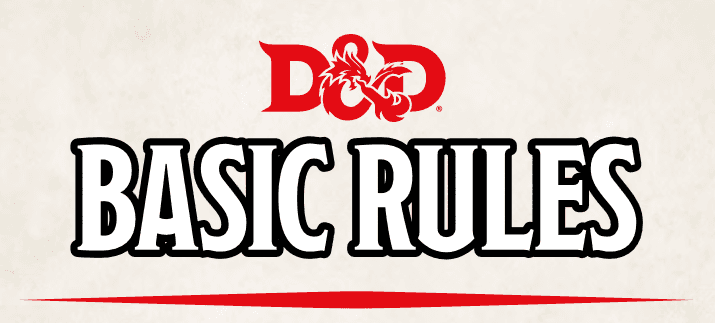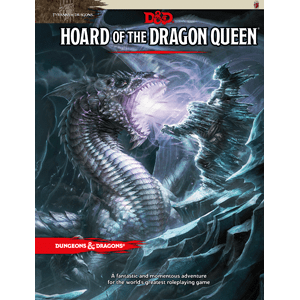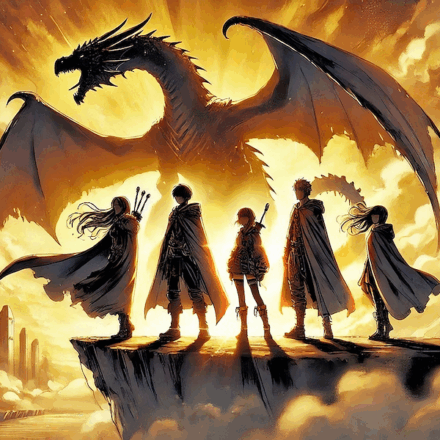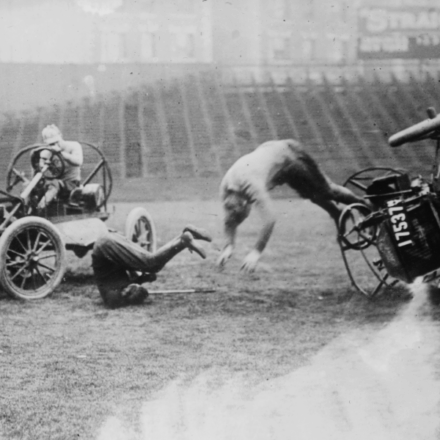I was speaking with a friend who enjoys roleplaying, but hasn’t done a lot of it until recently (he’s first a board gamer, but loves a number of geeky games). He began running the Starter Set for friends, but given the other more recent releases, he was confused about what’s necessary, what’s required, what’s optional, etc. for D&D. Joe, and anyone else who is wondering how to start off with this new edition of D&D, here’s my overview of what’s out there and what you need.
The Starter Set
 If you’ve been nominated as the GM for your group and you’re not an experienced GM with an adventure already in mind, this is the product for you.
If you’ve been nominated as the GM for your group and you’re not an experienced GM with an adventure already in mind, this is the product for you.
Inside the starter box are dice, premade characters ready to hand out to your players, a short (32 page) book with rules for players covering exploration and combat, and a longer book (64 pages) that is an adventure that’s ready for a GM to run without additional preparation. The adventure book has additional rules and some guidelines for adjusting the adventure for different play groups (so if you have a bigger or smaller group than the 4 or 5 players who are the default assumption for the adventure, there’s text to help you adjust the adventure for your table).
If you’re looking for a one stop, “Let’s try this out as a self-contained trial” box, the Starter Set can’t be beat. It’s pretty inexpensive ($19.99), and is designed for new players and new GMs.
Player’s Handbook
The Player’s Handbook is like a much expanded version of the 32 page player’s book in the starter set. It’s about 10 times as long… so there’s a lot of extra information.
The extra space comes in several forms. The first new large element in the Player’s Handbook is character creation rules. If you’re looking to build a character of your own, this book has the rules for making the widest variety of characters. In the starter box, you have 5 specific characters planned out for you. In the free PDFs below, you’re provided with 4 races and 4 classes (though not all variations within those classes). This book provides 8 races and 12 classes, with the rules for characters throughout their careers (to level 20), instead of the 4 levels that are provided on the starter set characters. There’s also a chapter on creating a character’s personality and background that produces the character description, personality traits, ideals, bonds, and flaws. This is already worked out for the 5 individuals in the starter box and listed on the character sheets.
The combat chapter is similar to the Starter Set version; while the Player’s Handbook chapter is longer, it’s mostly more expansive on the same topics. The Player’s Handbook also provides concrete rules for unusual cases, like wrestling, that can be improvised from the Starter’s Set rules, but it saves you from having to work them out for your table under pressure.
The five pages of the Starter Set labeled Adventuring expands to several chapters of the Player’s Handbook. Spellcasting is quite similar between the two… but the Spell Lists in the Player’s Handbook takes up several pages, since there are 9 levels of spells for 8 casting classes. Similarly, the 8 pages of spells from the Starter Set balloons to over 75 pages in the Player’s Handbook.
An important note is that the Player’s Handbook rules are exactly the same as the Starter Set–characters from the Starter Set can adventure alongside the characters made with the more extensive rules and they’re completely compatible (you could use the full rules in the Player’s Handbook to create the Starter Set pregenerated characters). The Starter Set doesn’t change the rules in the process of simplification–the same topics are covered with brevity and consider fewer unusual cases, rare equipment, or situations that won’t occur in the Lost Mine of Phandelver.
The Inexpensive Option
 You can get the basic rules for the game off of the Wizards of the Coast website for free. The rules are currently available in two PDFs: one labeled for players (that both players and GMs should read), and a PDF for GMs.
You can get the basic rules for the game off of the Wizards of the Coast website for free. The rules are currently available in two PDFs: one labeled for players (that both players and GMs should read), and a PDF for GMs.
The GM’s PDF is quite new (at the end of August)–right now, the first 55 of 61 pages are stat blocks (rules but not descriptions) for common monsters and NPC foes. This is followed by four pages of advice on building encounters (putting those monsters that you just read about into your adventure) and two pages of magic items.
The Player’s PDF has been out longer, so it’s probably more stable. It’s currently 115 pages–so there’s a lot of additional information here that wasn’t in the beginner’s box. The biggest difference between the Starter Set’s 32 page book for players and this PDF is the character creation chapter. Character creation in this PDF allows you to pick from the most common 4 races, and the traditional 4 classes–the classes that result in the characters in the Starter Set.
The chapters in the PDF match the chapter titles and the order of the Player’s Handbook. Much of the text of the character creation chapter matches the language in the Player’s Handbook–the example is building Bruenor in both books, the race pages look like they’re exactly the same as in the Player’s Handbook, including the fiction quotes. Similarly, the text of the classes is almost exactly the same, except that your path within the class has been picked, and only that path is listed. For example, all clerics created by the player’s PDF will have the life domain, instead of picking their domain. Here’s how that works for the fighter:
At 3rd level, you choose an archetype that you strive to emulate in your combat styles and techniques. The Champion archetype is detailed at the end of the class description; see the Player’s Handbook for information on other martial archetypes. Your archetype grants you features at 3rd level and again at 7th, 10th, 15th, and 18th level.
The remaining chapters are very similar to their Player’s Handbook equivalent. The PDF Chapter 4: Personality and Background, is almost identical to its Player’s Handbook equivalent except that a few backgrounds are missing. Chapter 6: Customization Options is the main exception to the rule. Chapter 6 doesn’t match the Player’s Handbook at all–instead of detailing the options, they list them, and instruct you to see the Player’s Handbook for the rules. The rest of the book through the spells chapter is very similar to the Player’s Handbook. Spells includes most* of the spells up through 9th level for both Clerics and Wizards, but only those two lists. (There’s not much reason to list bard spells, since you can’t make a bard with this PDF.) Appendix A and B are quite similar (though only the Forgotten Realms deities are listed in the PDF). Appendix C in the PDF describes the Forgotten Realms factions from the Lost Mines and Hoard of the Dragon Queen adventures, while the Player’s Handbook Appendix C describes the Multiverse instead.
But What Do I Need?
If you are a beginning GM, especially if your players are also new, you can confidently ignore everything but the Starter’s Set. Let everyone pick characters from the pregenerated characters in the box and start the adventure. You should get several sessions of fun out of the Lost Mine of Phandelver, and you’ll soon know if D&D is something that you and your group enjoy enough to keep doing. Hopefully you’ll love it and want to keep playing–or want to play again with new characters–when you’re through.
If your players have tablets, or don’t mind reading tiny text on their phones, encourage the spell casters’ players to download the player’s PDF. Each player will then have the list of spells and the spell descriptions, which is useful when it’s time to select their spells after a long rest–it may cut down on passing the book. It also means they don’t need the book passed to them when it’s time to let the magic missiles fly!
As the GM, there’s no reason to download the GM’s PDF until the Lost Mine nears its end. If you want to continue the adventure, the DM’s PDF gives you a lot of foes to use, and a basic understanding of how they can be combined to challenge but not overwhelm your players. The closing paragraphs of the adventure sketch out interesting ideas for a next adventure, if you want to try your hand at creating your own.
If your players want to create custom characters instead of using the characters supplied in the Starter Set, either the PDF or the Player’s Handbook will let them create their own. Using the PDF allows a lot of variation of the races and classes that you saw in Lost Mine. If your players are experienced, or excited by the idea of creating a very different character, the Player’s Handbook is what they’ll want (as a new GM, don’t be afraid to say “No” if you’re not ready to tackle that new material. It’s perfectly reasonable to require that everyone finish Lost Mines with the Starter Set characters, before you’re forced to master more material!).
As the GM, the Player’s PDF has information on new situations, and rules for specific situations (like how to handle light, or riding horses). Whenever you feel comfortable with the Starter’s Set rules, you can pick up the Player’s Handbook or, if you prefer electronic books, the player’s PDF. The adventuring, equipment, and combat rules are the same in those two mediums, so pick out the version that’s convenient for you to use at the table. Bring in the extra rules whenever you think they’ll benefit the game–if they clarify something that you made a quick decision about last session, or if the PCs head to a big city and you want to show off the extra products available at the market.
 If you and your players reach the end of Lost Mines and want to play more D&D, you can create your own adventures–but that’s a little tricky, since guidelines for doing so are coming in the Dungeon Master’s Guide in November. If you’d rather not make it all up, you have two easy directions at the moment.
If you and your players reach the end of Lost Mines and want to play more D&D, you can create your own adventures–but that’s a little tricky, since guidelines for doing so are coming in the Dungeon Master’s Guide in November. If you’d rather not make it all up, you have two easy directions at the moment.
- You can have the players create new characters (or use the same pregenerated characters from the Starter Set) and begin the Hoard of the Dragon Queen adventure from the beginning, with them using the characters at level one. If everyone tries out a new class, it can feel very different, since the adventure is new and people are playing new (or new to them) characters.
- The same characters who finished the Lost Mine can continue their adventure in Hoard of the Dragon Queen. To do this, read the first few chapters of Hoard of the Dragon Queen and create a transition scene or two (perhaps someone in their faction asks them to help out with the situation), flip to Episode 4 on page 28, and continue their adventures.
Have Any Questions or Advice?
If you’re a new GM, do you have any burning questions? Has your group already reached the end of Lost Mine of Phandelver? If you’ve forged ahead, please share your advice! If you have questions, we’ve got a great community of GMs to help you out.


















Great article Scott! I really appreciate the PDFs. I’m still in that place where I look at all of my 4E books and then shudder at the thought of spending money on a new edition. Having access to the player PDF eases my pain, and let’s me help out a bit at the table.
Do you have any advice for a more experienced player playing with a group of new players? Sometimes I worry about “driving the player bus” when we get together.
I’ve been in that boat, and it can be tricky. One way that can be fun is to borrow techniques from fiction and make your PC an unreliable narrator.
Specifically, look at the roleplaying elements on your character sheet (personality traits, ideals, bonds and flaws), and play strongly to those. This works best if you move planning and strategy into in character dialogue–so your fellow players will smile when Bruenor tells them that planning is for twiggy little wizards, unlimbers his axe and marches down the lane.
As much as possible, be a rules resource for your fellow players (and GM)–but help more with resolution (how your mighty leap over the chasm gets handled by the rules), instead of selecting the optimal approach.
I have trouble with this too, so I hope some we get some good comments to help you (and me) out with this common problem.
I think the Starter Set is definitely the way for new GMs to go. It has all the components you need to run an adventure. It’s enough that they can decide if that game is for them.
I’d say with the new release of the DMs Basic Guide and all the monsters therein, an experienced GM can take that and run almost any old module they already possess with confidence. Mostly likely the substitute stats are available in the download or an appropriate substitute can be found in the pack.
I’d only caveat that with a suggestion to check the total monster XP against the encounter budget, to be sure that the same monsters didn’t get a lot tougher in the new version and leave you surprised.
The second caveat I’d make is to consider most 4th edition modules a couple of levels tougher than their 5e equivalent–characters had a lot more powers and hit points at low levels. But scenarios from old basic D&D through 3.5 are probably about right to convert straight across.
(I kind of want to run the Isle of Dread as a rough conversion, now that you’ve put that thought in my mind.)
I believe the Murder at Baulder’s Gate module was written with 5.0 in mind and easy to convert if you are looking a more urban campaign after the starter set. This might be fun if your players had a fun time with the politics and ruffians in Phandelan
Fantastic article! I suspect I will be linking quite a few people here in the weeks to come.
One correction – the Basic Player’s PDF doesn’t include all of the Cleric and Wizard spells in the Player’s Handbook. There’s still a great selection, enough to run a campaign with, but there are quite a few spells not in the Basic PDF.
Thanks for the note; it’s good to know that the basic PDF provides sufficient spells so you can build a variety of characters, but not all of the spells. That’s an interesting decision–I wonder how they decided which spells would go in the PDF and which are reserved for the Player’s Handbook.
I updated the article to note that most rather than all of the Cleric and Wizard spells are in the PDF.
Thanks for the overview of the various starter products out there.
The important things that I’ve picked up from playing in a 5E game is to understand how skill (and kit!) proficiencies work, and to remember that you’re getting character abilities from three sources: Race, Class, and Background.
Aside from those oddities, I think 5E is pretty easy for old and new players to grasp.
Also, I’ve seen a Monster Manual. (Basks in reflected glory.) I really like the way they’ve approached monsters. A lot.